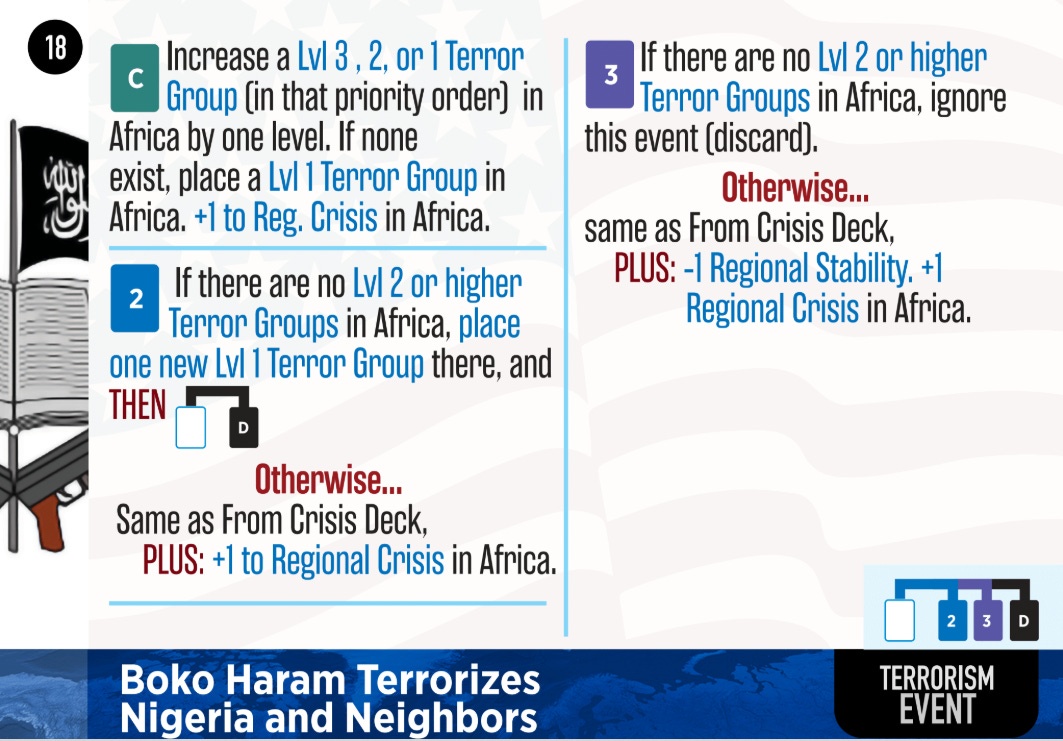Disasters, Chaos, and Terror
Not all Crisis Cards are equal
I’ve already written about the Crisis deck in Mr. President, but that post covered just the basics, and the concept of Cascading Events. Here I want to talk about even more specific types of Crisis cards: Natural Disasters and Terrorism events.
First, let’s look at some Natural Disasters.
This card represents a catastrophically severe drought in California. Natural Disaster cards share a format: they usually allow you to spend some Action Points on your initial response - and this is one of the key reasons to retain some Action Points throughout the year, in case of a natural disaster - and potentially make some political gains. Moreover, you’ll notice that on the best possible result (which is not available unless you spend at least 1 Action Point), the second stage of this card is skipped; it goes to the ‘3’ pile, so you can only draw it once more.
The drought is also rare in that in its future recurrences, there’s a chance you’ll just get bailed out by the weather, and the card goes straight to Discard with no further effect. Most natural disasters aren’t like that, though:
This card can’t get discarded by a lucky rain result (indeed, rain would make this one worse!). But, like the California drought, it’s a blow to the US economy, and the political fallout if you under-invest your Action Points (political capital) can be dramatic. The aftermath can also create a drag on your domestic tracks, which is very dangerous in year 2 when you need all the domestic track position you can get to maximize the chances of a good result in the midterm elections (or, in year 4, your re-election campaign!).
There’s also a hidden risk. Note that the aftermath effects can include Domestic Crises. If you don’t manage these correctly, you risk a Domestic Failure (that’s what happens if your Domestic Crisis level rises to 3). To control that risk, you’ll need to spend precious actions on “Address a Domestic Crisis.” So it’s not just public disapproval and tension with Congress and the Cabinet that these cards can drive - they’re also a subtle action drain.
Now let’s take a look at a Terrorism Crisis. These vary in structure much more than Natural Disasters do, and their effects and resolution depend on the target. For example, here’s a domestic terror attack:
Here, your Homeland Security level is paramount. A Homeland Security check is a d10 against the track rating, which ranges from 8 (robust capabilities) to 3 (compromised). If you pull this card, and pass that check, the attack is averted (well done!). You’ll get public approval and an RNG-free ding on a terror group anywhere you like.
But for an attack like this, the price of failure is severe. FOUR Tensions markers go on your Cabinet Priorities list, which means that anything but your top two priorities won’t even get rolls at the next resolution. And the Legislative Segment is skipped (possibly twice, if this is drawn early in the year)! However, you’re able to start an air campaign against the Rogue State you deem responsible, without needing to wait until an Action segment or spend Military actions to move the necessary air assets or actually kick off the offensive.
For a very different example, let’s take a look at this card:
This card represents a wave of terror attacks and operations in multiple African countries, rather than a single attack. As such, it’s handled as a Cascading Event rather than a one-time event. It leads to the buildup of African terror groups’ strength (represented in the card by Boko Haram), and pushes Regional Crises there pretty hard. Since a Major Regional Crisis in Africa can cause a refugee crisis, the spillover risk is significant. But you can play around this by aggressively assisting African states with anti-terror support - if you’re able to bring terror groups’ strength down such that there aren’t any at Level 2 or higher when you draw it again, this card will get pitched.
Here we have a dramatic terror attack against a highly symbolic target, but not in the U.S. In this case, the French will take unilateral action to deal with the attack, and will expect your support. If you don’t provide it, that’ll bruise relations with the EU - but in this case, the 2 Action Points provide a big die roll modifier, representing close collaboration and relationships between American and European anti-terror institutions and agencies. If the free Intel attempts result in identification and targeting of the responsible group, you’ll also get a free SpecOps raid against that group, likewise with a bonus.
I hope this deep dive on some of the nastier events in Mr. President has been exciting, if a bit worrisome! Look for Mr. President on Steam later this summer, and please do add it to your wishlist!
One Crisis After Another: The Crisis Deck in Mr. President
We call Mr. President a sandbox game. One important reason for this is the large Crisis deck, which provides players a widely variable set of unexpected challenges in every game. There are a lot of curve balls the game can throw at a player, but the barrage of Crisis Cards is one of the most important and fun ways the game provides for a player to tell …







